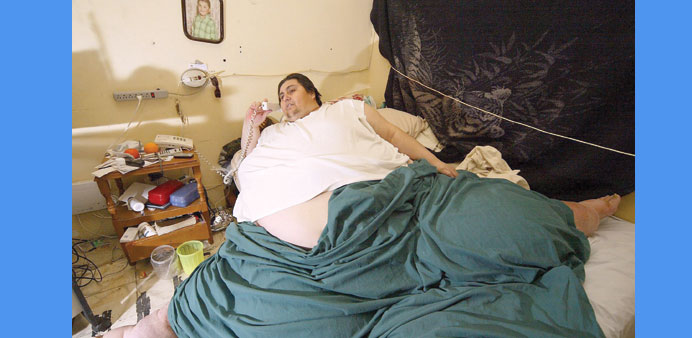A file photo taken on 17 January 2006, showing Manuel Uribe of Mexico, at the time 40 years old and weighing 597 kilograms, in Monterrey, Mexico. Uribe died on 26 May 2014.
By Georg Ismar
If Alberto Brenner Junior is right, it is not going to be easy being a pallbearer at the Penitencia Cemetery in Rio de Janeiro.
The graves offered by Brenner, the cemetery’s director, are 1.3 metres wide by 2.4 metres long. Each grave is meant for just one person. And that person, carried to his or her final rest by the pallbearers, could weigh as much as 500 kilos.
Brenner, a businessman, believes he’s spotted a sizeable gap in the market in Rio.
“52 per cent of adult Brazilians are overweight nowadays,” he says citing an official study.
This despite the city’s status as host of the 2016 Olympics, despite its cult of the perfect body and strutting that body on the Copacabana, the same beach where you will find steel frames every few hundred metres to do chin-ups on.
The fact of the matter is Brazilians also love burgers and sweets, and in the past nine years, according to the Health Ministry, the number of overweight people has gone up by 23 per cent.
Brenner’s cemetery is located right by the city’s harbour. He has six “show graves” so-to-speak and plans to accommodate another 1,260, most of which will be built on top of one another.
They’re designed to offer two square metres more space than normal plots. The bigger tombs made of granite are made to hold corpses weighing 350 kilograms with an upper limit of 500 kilograms.
Mexico’s Manuel Uribe, who died last year and at his heaviest weighed 560 kilograms as the fattest person in the world, had to be cremated because there were no coffins big enough to hold him.
Brenner is also planning a crematorium which will offer a 24-hour service. “Overweight people need a bit more time,” says Brenner.
The expansion of the cemetery, which first opened in 1865, is set to cost 55 million reals (16.4 million dollars).
Many Portuguese families are buried there, some in very fancy mausoleums, and a walk through the graveyard is like taking a stroll through Brazilian colonial history.
In Rio, which has a population of 7 million, and the surrounding area, 5,500 people die every month, according to Brenner.
How many people already hardly fit in a normal, 80-centimetre-wide grave, he can’t say.
The heaviest person they’ve ever had to bury at the cemetery? “I reckon about 250 kilograms,” says Brenner.
But the big question remains: Will there really be a demand for these graves? Brenner is enjoying the attention attracted by his plans and knows how to sell them — he’s got a lot of headlines.
But the XXL graves come at a cost of 75,000 reals — an expensive end to a substantial life.—dpa

